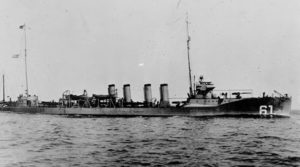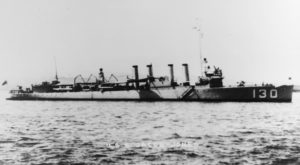The sinking of two destroyers named USS Jacob Jones and how the USS Roper avenged one
This is the tale of two unlucky destroyers named for an unlucky commodore, and the destroyer that avenged one of them.
Perhaps the name, Jacob Jones, was cursed. Jacob Jones was born in Delaware, but was an orphan by the age of four. He eventually became a doctor, found love and married but his wife died not long afterwards. Once again, he was alone and grief stricken. Abandoning his medical practice, he joined the U.S. Navy as a midshipman at the old age of 31 when it was common for boys as young as 10 to come on-board as a midshipman.
Jones’ luck turned even worse. He and the rest of the crew of the USS Philadelphia were captured by Barbary pirates in 1803 and not freed until 1805. He was captured again at sea by the British during the War of 1812. Released, he lived a productive life in the U.S. Navy until his death in 1850.
But, starting 67 years after the commodore’s death, Jones’ bad luck returned. Two of the three ships named for him would be sunk.
 The first USS Jacob Jones (DD-61), a Tucker class, was not one of the original American destroyers in the squadron sent to Queenstown, Ireland, in May 1917 to begin our nation’s participation in World War I. She was left behind to act as a mail ship, but the bad luck associated with the Jones name continued. At some point during a short stay in Philadelphia, someone, probably a crewman, opened her sea cocks in an effort to sink her at the dock. The sabotage was discovered only after two feet of water had filled her hull.
The first USS Jacob Jones (DD-61), a Tucker class, was not one of the original American destroyers in the squadron sent to Queenstown, Ireland, in May 1917 to begin our nation’s participation in World War I. She was left behind to act as a mail ship, but the bad luck associated with the Jones name continued. At some point during a short stay in Philadelphia, someone, probably a crewman, opened her sea cocks in an effort to sink her at the dock. The sabotage was discovered only after two feet of water had filled her hull.
The Jacob Jones eventually did make it to France as part of a squadron escorting convoys. She was sunk on December 6, 1917, by a German U-boat off the southern coast of England. Hit by a single torpedo from the U-53, one of Germany’s most successful submarines, some of DD-61’s crew was killed by the initial explosion. More were killed when sinking depth charges exploded underneath the survivors floating in the water. She was the only American warship lost to enemy action in World War I.
 The second USS Jacob Jones (DD-130), a Clemson class, was given the Jacob Jones ship name while still being constructed in February 1918 in honor of the destroyer that had been lost just three months earlier. USS Jacob Jones (DD-130) sailed widely during the 1920s and 1930s and seemed to have shaken off the bad luck.
The second USS Jacob Jones (DD-130), a Clemson class, was given the Jacob Jones ship name while still being constructed in February 1918 in honor of the destroyer that had been lost just three months earlier. USS Jacob Jones (DD-130) sailed widely during the 1920s and 1930s and seemed to have shaken off the bad luck.
On Feb. 22, 1942, the Jacob Jones thought it had encountered a U-boat just outside New York City’s harbor. She dropped 57 depth charges on a contact, resulting in an oil slick rising to the surface, but no wreckage. Despite the captain’s protests to his superiors that the target was moving, the Jacob Jones was not credited with finding a U-boat.
On Feb. 28, 1942, while cruising off Cape May, N.J., she was hit by two torpedoes, fired by the U-578. Only 13 crewmen survived and one of them died after rescue.
The similarities in the sinkings of the two Jacob Jones are striking. DD-61 was the only American warship lost to enemy action in WW I. DD-130 was the only American warship lost to enemy action in American continental waters in WW II. Both were sunk by U-boats at night. Both lost crewmen to their own depth charges exploding and killing survivors floating in the ocean. Both lost most of their crews.

USS Roper
On April 14, the USS Roper (DD-147), a Wickes class, would get its revenge for the loss of the Jacob Jones. The Roper was already famous in the United States for having rescued a lifeboat with a newborn baby on-board. The mother had been so grateful to the crew that she named the baby Roper. The birth and rescue of the baby made national news.
The Roper was cruising off Nags Head, N.C. on April 14, 1942, when it made a surface radar contact that the captain thought could be a patrolling Coast Guard ship. He ventured closer and was rewarded with a torpedo passing his destroyer’s length. The Roper turned on its search light and spotted the U-85 running on the surface. One of the Roper’s 4-inch deck guns hit the conning towner before the submarine could submerge. Most of the sub’s crew abandoned their submarine before it sank beneath the waves.
The Roper’s captain was not positive that the submerged submarine was damaged enough to have sunk. He thought the captain had submerged to avoid more gunfire. The Roper continued to drop depth charges, which killed all of the U-boat crewmen in the water. Later questioned if he could have rescued the crewmen, the Roper’s captain explained he thought another U-boat could be in the area. To pick up the Germans would have meant stopping his destroyer, giving any lurking submarines an easy target.
The U.S. Navy tried to examine the U-85, sunk in less than 100 feet of water, but no effort was made to go inside it. Had divers using rebreathers or air hoses gone inside, they might have recovered an Enigma coding machine. That was finally brought to the surface by sport divers in the 1990s.
To this day, some stories still circulate that the U-85 was trying to drop off spies, but those stories seem unlikely. All of the crew could be accounted for as crewmen from papers recovered from their bodies. No one extra was on-board. Even if spies had been aboard, the action was 18 miles at sea, hardly where she would be in preparation to dropping off spies in rubber boats. And, if they had been dropped off, the spies would have had to cross another sound to reach the North Carolina mainland. And if they had reached the mainland, there was nothing there to sabotage; no defense plants, no cities, not much of anything other than pine forests.
It was an early victory for the U.S. Navy against the U-boats that would roam the American Atlantic coast for the next year. The second USS Jacob Jones (DD-130), sunk just six weeks earlier, had been avenged.
One other ship would pick up the name USS Jacob Jones (DE-130), commissioned April 29, 1943, just over a year after the Roper had sunk U-85. The Navy even assigned the third USS Jacob Jones the same number as the second USS Jacob Jones. The destroyer escort would lead an uneventful service during the rest of the war, never encountering the enemy. She would be sold for scrap in 1973.
Whoever assigns ship names in the U.S. Navy has not tested fate again. So far in the 21st century, the USS Jacob Jones name has not been assigned to another destroyer. (All U.S. naval destroyers are named after naval personnel who have established themselves as heroes.)